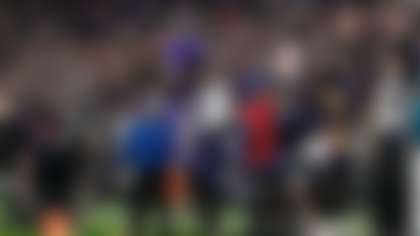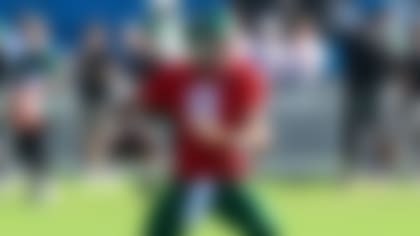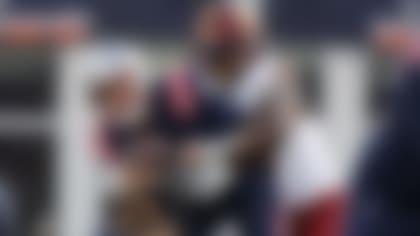In this four-part series, I'm using my context-based data models to evaluate some of the top draft prospects at four key positions -- edge rusher, quarterback, cornerback and wide receiver -- while providing pro comparisons and ideal team fit for each.
The goal for the comps: showing some of the strengths, weaknesses and unknown résumé aspects for each prospect, while offering a perspective to approximate how team analytics departments might view the player's potential NFL impact.
The goal for the team fits: maximizing the draftee's 2023 win share, factoring in what we know about each team's personnel, coaches and strategy right now. And of course, as much as possible, I'm aiming to present realistic matches, ones that could actually come to fruition on draft day.
We're far enough into the pre-draft process that we've gathered a lot of information on the top five QB prospects. So to evolve this concept a bit, I thought I would add a little extra to my comparisons. I used to work in the investment world, where it was common to hear elevator pitches for startups that combined the traits of two known companies: for instance, describing OpenTable as "Expedia, but for restaurants," or describing Rent the Runway as "the Netflix of dress rentals." (I'm dating myself, because this was back when Netflix used to distribute physical DVDs in the mail.)
I decided to shift a few of the parameters of my model to yield clusters of QB results instead of just one comparison for each pro hopeful. Hopefully this adds a layer of context and extra texture to your understanding of the prospects below:

PRO COMPARISON: Tua Tagovailoa + Teddy Bridgewater
Yes, the 5-foot-10 Young is outside of the current median range in height, but he's played with and against players whose dimensions are similar to the players he'll be working among at the NFL level, so we can lean on his exceptional college production (against NCAA players of the highest caliber) when projecting whether his size will factor into his pro success. Of this year's crop of QB prospects, Young has the best college film. Not only was Young the best passer in the FBS in 2022, per Pro Football Focus' grade (91.3), but he led all FBS QBs in passing yards (2,363) and passing TDs (27) when under pressure in his three seasons at Alabama, per PFF. Computer vision shows that Young's passing under pressure increased in accuracy, even when off-platform, in each collegiate campaign.
There are definite parallels between Young and the similarly undersized Drew Brees, which is a comp I've heard from many scouts and front office/personnel people that I trust; for example, in Young, I see Brees' accuracy when making intermediate throws from a clean pocket and his center of gravity when running. But because my models focus on the past 15 seasons of data, with even more importance on the past 10 seasons, I wanted to go with QBs who made the college-to-pro leap more recently than Brees, who entered the NFL in 2001 and retired in 2021.
In addition to Brees, Young shares his accuracy from the pocket with Tagovailoa; both Young and the Dolphins QB excel at making plays with multiple reads and progressions. Tagovailoa (6-1) is taller than Young, but he is also outside of the current median range in QB height, and he was similarly prolific with the Crimson Tide. Of the QBs selected in the first round who measure 6-1 or shorter over the past 15 years, Tagovailoa has the best passer rating (95.0), with a 65.7 percent completion rate and a TD-to-INT ratio of 52:23. Young's passing platform is similar to Bridgewater's in terms of hip movement and leg placement. In his two most recent seasons as a regular starter (2020 and '21), Bridgewater ranked eighth in completion rate (68.1%) among those to attempt at least 200 passes. I also see Bridgewater's change-of-direction speed on runs.
TEAM FIT: Houston Texans
The potential for Young to have extended dropbacks and/or more time in the pocket playing behind a tackle of Laremy Tunsil's caliber makes this a nice match, as should Young's familiarity with former Alabama receiver John Metchie.

PRO COMPARISON: Dak Prescott + Jared Goff
Stroud has the pocket-first-but-run-when-necessary profile that exemplifies my model's highest floor for QBs, based on how the game has evolved in recent seasons. PFF shows that, against the blitz in 2022, Stroud led the FBS in passer rating (133.2) and had the second-most passing TDs (21). His lower body movement calls to mind Prescott, as does the résumé of throws he made at the college level. Prescott claimed the 2016 Offensive Rookie of the Year award with an efficient debut campaign (67.8 percent completion rate, 23:4 TD-to-INT ratio, 104.9 passer rating), though it's important to note that Prescott wasn't asked to complete very many low-probability passes, given the incredible offensive line and exceptional running back in Dallas that season. Even if the supporting cast doesn't compare wherever Stroud ends up, it would be prudent to avoid putting Stroud in hero ball situations.
To me, this comp is 65 percent Prescott and 35 percent Goff. Goff and Stroud both increased their accuracy in the pocket and expanded the types of throws they were expected to make while facing tough defenses at the college level. They both also excel at play-action: Stroud used it on 37.6 percent of dropbacks last season, ranking second among Power Five QBs and fourth among FBS QBs with a 139.0 passer rating on such passes. Goff was one of the NFL's premier play-action QBs in 2022, compiling a sparkling TD-to-INT ratio (17:3) and passer rating (127.3) on such attempts. Leaning on play-action is a very smart strategy for modern QBs, especially when beginning their pro careers.
TEAM FIT: Carolina Panthers
With Frank Reich as architect of the offense and Duce Staley creating the running-game opportunities, there's a strong match between Stroud and the new Carolina regime. Furthermore, with the NFC South looking as fluid as it does in 2023, Stroud with the Panthers would be the most likely rookie QB to lead a team to the playoffs, as I see it.

PRO COMPARISON: Carson Wentz + Jalen Hurts
Richardson is a tough one for me to project; he's generated some of the most volatile data I've seen in the 15-plus seasons of information I'm considering. The relatively small sample size (Richardson logged one full season as a starter, with 393 pass attempts in three total seasons, at the collegiate level) only increases the uncertainty. Because of positional value, Richardson seems likely to be drafted in the first round -- and if he hits his (very high) ceiling, he'll be worth it. But the potential floor means there's a level of risk to drafting him anywhere before Round 3.
It's fitting that one of the comps I see is Wentz, who once put up MVP-caliber production for the Eagles (in the 2017 season), but also played his way out of three cities (Philadelphia, Indianapolis and Washington) over the past three seasons. In addition to a similar knack for improvisation, Richardson has Wentz's ability to put velocity on his throws, as reflected in his average depth of target (11.5 yards, sixth-highest among Power Five QBs who attempted at least 100 passes in 2022, per PFF) and his short-of-sticks percentage (40.3, the lowest in the SEC and the 10th-lowest in all of FBS, also per PFF).
Richardson also possesses Wentz-like burst (within the first 3 yards traveled on designed runs) as a rusher. PFF gave Richardson the second-highest rushing grade (84.8) among QBs in the Power Five in 2022, with much of that grade seemingly derived from his 25 forced missed tackles on runs, tied for sixth-most among Power Five QBs. One of my favorite metrics Richardson displays is his ability to keep his center of gravity low (relative to his height), in which he ranks in the top 10 percent of players in a 10-season sample. How a QB performs according to this metric helps forecast their change-of-direction skills with the ball in their hands. That is one area where Richardson reminds me of Hurts, along with his ability to recover after contact and make a play. Hurts, of course, took over for Wentz in Philadelphia and cemented himself as a franchise QB with a stellar 2022 (3,701 yards, 22 TDs, six picks passing; 760 yards, 13 TDs rushing).
TEAM FIT: Seattle Seahawks
I'm not suggesting the Seahawks should immediately replace veteran QB Geno Smith, who just signed an extension. Rather, Smith could be part of a long-term plan to develop Richardson for at least one season, if not longer. With two first-round picks, Seattle is among the teams in position to take a smart swing on Richardson's upside. (The Colts, whose new head coach, Shane Steichen, created some magic for Hurts during his time as the Eagles' offensive coordinator, also look like a strong match, even if they might have to use the fourth overall choice on Richardson).

PRO COMPARISON: Sam Darnold + Jay Cutler
Levis has the pocket-passing skills of Darnold and the arm strength of both Darnold and especially Cutler when the latter was coming out of Vanderbilt. Like Cutler, Levis was able to make power throws despite having a less-than-stellar supporting cast at the collegiate level (they also have similar centers of balance). The difficulty is forecasting what Levis' arm strength will translate to in the NFL, where he'll be working with an improved offensive line and better skill position players. His strong performance in play-action in 2021 (1,255 passing yards, 14:5 TD-to-INT ratio, 117.3 passer rating, per PFF) is notable, given that, again, leaning on play-action can help a QB transition to the pros. But it is not encouraging that Levis appeared to stall in 2022, even taking into account the time he lost to injury last season; his PFF passing grade slipped by almost 20 points, from 82.3 in '21 to 65.8.
TEAM FIT: Los Angeles Rams
My models would love for all QBs to get a chance to learn for a season in the pros before making their first start, but Levis' step back in 2022 suggests that it would be even more beneficial for him than the typical prospect. The Rams' earliest pick is currently in Round 2 (No. 36 overall), but if they can acquire Levis, he would find a strong role model in incumbent veteran Matthew Stafford, who possesses a big arm and exceptional decision-making ability.

PRO COMPARISON: Jacoby Brissett + Daniel Jones
Hooker combines Brissett's ability to execute and read progressions with Jones' throwing velocity. His season was ended prematurely by a torn ACL in November, but he still registered the second-highest passer rating (123.9), the second-best rate of turnover-worthy plays (1.0%) and the most passing yards per attempt (9.5) in the FBS last season, per PFF. Hooker used play-action on 53.5 percent of dropbacks (third-highest rate in the FBS) last season and posted the sixth-highest passer rating when using it (133.1); he also threw 18 TDs against just one interception (fifth-best rate) on such passes. Performance in a clean pocket can help approximate the best-case scenario for a QB, and Hooker's passer rating in this situation (130.2), per computer vision, was the third-best in this class.
TEAM FIT: Atlanta Falcons
This one surprised me a bit. However, Atlanta's O-line includes three former first-round picks, while coach Arthur Smith is exceptional with run concepts; both factors forecast to drive smart uses of play-action, which is the key to unlocking Hendon at the next level, whenever he's ready to return to the field.
Follow Cynthia Frelund on Twitter.












